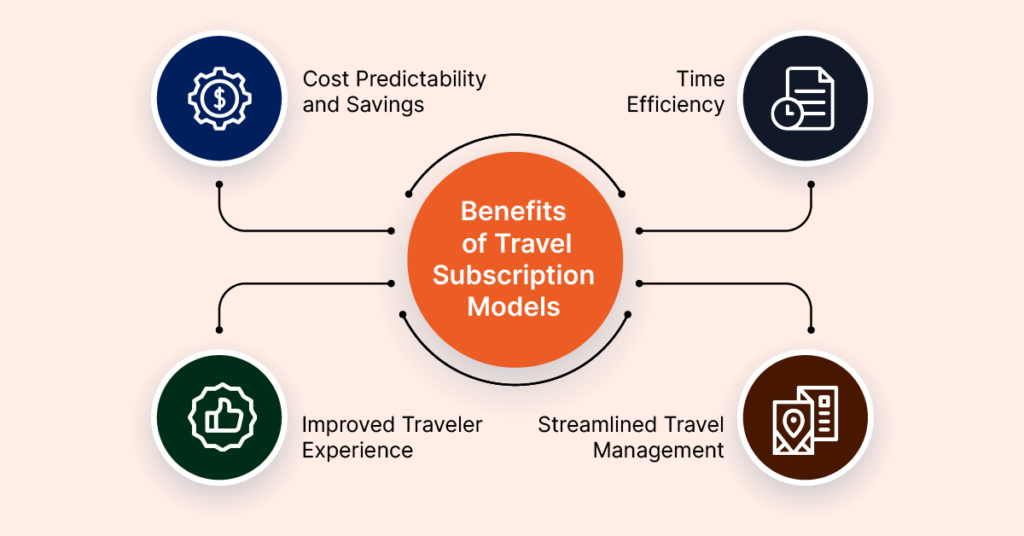
In recent years, the business travel landscape has undergone significant transformations, with one of the most notable trends being the rise of the business travel subscription pricing model. According to the Global Business Travel Association (GBTA), business travel spending is projected to reach $1.5 trillion by 2025; companies are increasingly searching for innovative ways to manage travel expenses. According to Business Standard, worldwide spending on business travel will top pre-pandemic levels in 2024 and expand to more than $1.78 trillion in 2027.
Hence, companies are looking for ways to manage their business travel spending. This trend was highlighted at the recent GBTA conference, where industry experts discussed the growing interest in subscription models for business travel. A report from the Boston Consulting Group indicates that more than 70% of companies are exploring subscription-based services to streamline their operations and reduce costs. As businesses continue to look for cost-effective and efficient travel management, the subscription pricing model is emerging as a game-changer in the industry.
This blog will highlight the problems companies face and provide more information on controlling business travel spending.
The Need of the Hour: Business Travel Subscription Pricing Model
Does your company often grapple with unexpected travel expenses that throw your budget off course? If so, you’re not alone. Traditional pricing models for business travel can feel like navigating a minefield—prices fluctuate, hidden fees pop up, and before you know it, you’re overspending.
Imagine booking a flight today at one price, only to find it’s doubled tomorrow. Sound familiar? These unpredictable costs make it nearly impossible to plan and stick to your travel budget accurately. Plus, the traditional model’s lack of transparency means you might not even see all the charges coming until it’s too late.
But what if there was a way to make your travel expenses more predictable and manageable? Enter the business travel subscription pricing model. Picture this: a flat, consistent rate for all your travel needs. No more surprise fees or price jumps—just straightforward, transparent pricing.
This shift simplifies budgeting and streamlines the approval process, making managing and tracking travel expenses easier. With subscription pricing, you gain control, clarity, and peace of mind, knowing exactly what your travel costs will be every time.
Traditional Pricing Models Vs. Subscription Pricing Model
This table highlights each travel model’s key differences and benefits, illustrating how the travel subscription model can offer a more predictable and streamlined approach to managing business travel.
| Feature | Traditional Pay-As-You-Go Model | Travel Subscription Pricing Model |
| Cost Structure | Pay for each service (flight, hotel, car rental) as you use it. Costs can vary. | Pay a flat fee for a bundle of travel services. Predictable costs. |
| Flexibility | Offers flexibility to choose services as needed, but may lead to varying costs. | Offers a set package of services, limiting choices but offering consistent options. |
| Budget Management | It is challenging to predict and budget due to fluctuating prices. | It is easier to budget with fixed costs, providing peace of mind. |
| Booking Process | Time-consuming and involves searching and managing multiple bookings. | Simplified and streamlined booking process, often automated. |
| User Experience | Requires active management and decision-making for each trip. | Provides a more hassle-free experience with everything managed in one package. |
| Cost Efficiency | Can be more expensive due to last-minute price hikes and lack of bundled discounts. | Potentially more cost-effective, avoiding price spikes and offering bundled discounts. |
| Control | More control over selecting specific flights, hotels, and other services. | Less control over individual choices, as services are bundled together. |
| Convenience | Less convenient, requiring more time and effort to manage. | Highly convenient, akin to having a personal travel concierge. |
Also Read: How to Choose among various TMC Pricing Models?
Challenges with Travel Subscription Pricing Models
While the travel subscription model offers numerous benefits, it has its challenges. Businesses should consider the following potential drawbacks before adopting a subscription-based approach:
- Initial Costs and Commitment: Subscribing to a travel package often requires a significant upfront investment. Companies must carefully evaluate their travel needs and ensure the subscription fee aligns with their budget and travel volume. Additionally, some subscription models may require long-term commitments, which can concern businesses with fluctuating travel needs.
- Limited Flexibility: The business travel subscription pricing models may offer a different level of flexibility than traditional booking methods. For example, a subscription package may restrict the number of trips, destinations, or accommodations included. Companies with diverse travel requirements may need help navigating these limitations.
- Service Quality and Availability: The quality of service and availability of travel options can vary between providers. Businesses must carefully assess the reputation and reliability of the subscription provider to ensure they receive high-quality services. There may also be concerns about availability during peak travel periods, as subscription models often operate on a first-come, first-served basis.
Approaches That Can Help Eliminate These Challenges
To overcome the challenges associated with travel subscription models, businesses can take the following steps:
- Conduct a Thorough Needs Assessment: Companies should comprehensively assess their travel needs before committing to a subscription. This includes analyzing past travel patterns, understanding employee preferences, and projecting future travel requirements. By identifying their specific needs, businesses can choose a subscription package that best fits their travel profile.
- Negotiate Flexible Terms: Companies should negotiate flexible terms with subscription providers to accommodate their unique needs. This may include the ability to adjust the subscription plan based on changing travel patterns or the option to cancel the subscription without penalties.
- Monitor Service Quality: To ensure a positive travel experience, businesses should regularly monitor the quality of service the travel subscription pricing provider provides. This includes gathering feedback from travelers, tracking service performance, and promptly addressing issues.
- Leverage Technology for Optimization: Advanced technology solutions like travel management software can help businesses optimize their subscription model. These tools can provide insights into travel spending, identify cost-saving opportunities, and enhance compliance with travel policies.
What are the Benefits of Travel Subscription Models for Businesses and Travelers?
The travel subscription model provides a plethora of benefits for businesses and travelers. Let’s have a look at some of them:
- Cost Predictability and Savings: One of the primary benefits of the travel subscription model is cost predictability. Companies can plan their travel budgets more accurately, knowing that a fixed fee covers their travel needs. This can lead to significant cost savings, as businesses can avoid the high costs of last-minute bookings and peak travel periods. A Global Business Travel Association survey found that companies using subscription models reported a 20% reduction in travel expenses.
- Time Efficiency: The business travel subscription pricing model simplifies booking by allowing businesses to book travel services through a single platform. This reduces the time spent searching for flights and hotels, comparing prices, and managing multiple bookings. Travelers can enjoy a seamless experience, with all their travel needs met through a single subscription.

- Improved Traveler Experience: Subscription models often come with additional perks, such as access to premium services, priority check-in, and lounge access. These benefits can enhance the travel experience, making business trips more comfortable and less stressful for employees. In turn, this can lead to increased employee satisfaction and productivity.
- Streamlined Travel Management: The subscription model simplifies travel management for travel managers by providing a centralized system for booking and tracking travel expenses. This can lead to better compliance with travel policies, reduced administrative work, and improved data analytics for optimizing travel strategies.
Examples of Business Travel Subscription Pricing Model
The travel subscription model is catching on across the industry, with various companies introducing innovative plans that cater to different types of travelers and business needs. Here are some examples that highlight the diversity and appeal of travel subscriptions:
itilite
itilite offers a flexible and transparent pricing model designed to simplify business travel management. With itilite, companies can opt for a subscription-based pricing model that provides predictable, flat-rate costs. This ensures businesses can manage their travel expenses more effectively, with no hidden fees or surprise charges. Whether you’re looking for budget-friendly options or comprehensive travel solutions, the itilite pricing model is tailored to meet the diverse needs of modern organizations, making business travel more efficient and cost-effective.
Lufthansa’s Flight Pass
Lufthansa, one of Europe’s largest airlines, has introduced the Flight Pass subscription model, which allows travelers to pre-purchase a set number of flights within a certain period or region. This is particularly beneficial for frequent flyers who travel regularly to specific destinations. The Flight Pass offers flexibility regarding travel dates and provides cost savings compared to booking individual flights. Travelers can enjoy a simplified booking process, knowing they have a set number of flights already covered.
Inspirato Pass
Inspirato, a luxury travel company, offers the Inspirato Pass, a subscription service that provides access to luxury vacation homes, hotels, and experiences. For a monthly fee, subscribers can book as many trips as they want, choosing from various destinations worldwide. The travel subscription pricing includes accommodations, travel planning services, and other perks, making it an attractive option for those who value high-end travel experiences.
Future Trends: Predictions for the Industry and Potential Innovations
As companies increasingly invest in SaaS to streamline operations, the business travel industry is shifting towards subscription pricing models. The future lies in predictable, flat-rate pricing that aligns with the simplicity of SaaS. For businesses already using SaaS, this model offers a seamless way to manage travel expenses. Even for those who have yet to invest in SaaS, solutions like itilite fully can make travel effortless, cost-effective, and aligned with modern needs.
As the travel industry evolves, the business travel subscription model is expected to gain momentum. Several trends and innovations are likely to shape the future of this model:
- Customization and Personalization: Subscription providers will increasingly offer customizable plans that cater to the specific needs of businesses and travelers. This could include tailored packages based on travel frequency, destinations, and preferences, allowing companies to create bespoke travel solutions.
- Integration with Corporate Travel Programs: As more companies adopt subscription models, there will be a growing need for seamless integration with existing corporate travel programs. This will enable businesses to manage all aspects of their travel—booking, expense reporting, and compliance—through a single platform.
- Sustainability Initiatives: The travel industry is increasingly pressured to adopt sustainable practices. Subscription models promote eco-friendly travel by offering options for carbon offsetting, promoting sustainable travel choices, and incentivizing travelers to choose greener options.
- Advanced Data Analytics: Data analytics will become more prevalent in subscription-based travel models. By analyzing travel data, providers can offer insights into travel trends, optimize pricing strategies, and enhance the overall travel experience for subscribers.
- Expansion of Subscription Services: Subscription pricing will likely expand beyond flights and accommodations to include a broader range of travel services, such as airport transfers, travel insurance, and concierge services. This will provide businesses with a comprehensive and convenient solution for managing all travel needs.
Also Read: Business Travel Sustainability Trends in 2024
Travel Subscription Pricing Models are Here to Stay
The travel subscription model is more than just a trend; it’s a transformative shift that offers a compelling alternative to traditional pay-as-you-go pricing. By providing predictability, convenience, and value, these subscriptions cater to the needs of modern travelers and businesses alike. As the industry continues to evolve, we expect to see more innovative solutions that address the challenges and capitalize on the opportunities presented by this new way of thinking about travel.
The discussions at GBTA 2024 have highlighted the growing interest and potential of travel subscriptions, making it clear that this trend is worth watching. As companies and travelers seek ways to simplify their travel experiences and control costs, the travel subscription pricing model will likely play a key role in shaping the future of travel. With continued innovation and adaptation to market needs, travel subscriptions are set to become a standard part of the travel landscape, offering new possibilities for exploration and connection.











